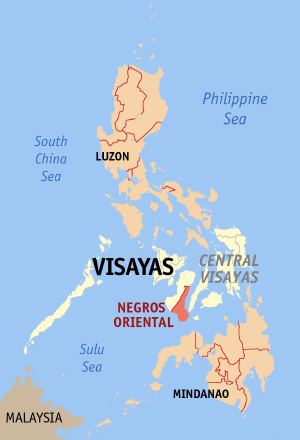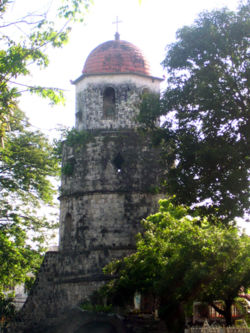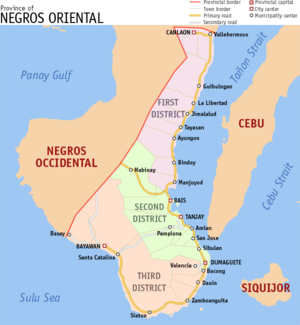Negros Oriental
2008/9 Schools Wikipedia Selection. Related subjects: Geography of Asia
| Province of Negros Oriental | |
 Provincial seal of Negros Oriental |
|
 Map of the Philippines with Negros Oriental highlighted |
|
| Region | Central Visayas (Region VII) |
| Capital | Dumaguete City |
| Divisions | |
| - Highly urbanized cities | 0 |
| - Component cities | 6 |
| - Municipalities | 19 |
| - Barangays | 557 |
| - Congressional districts | 3 |
| Population | 20th largest |
| - Total (2007) | 1,126,061 |
| - Density | 208/km² (41st highest) |
| Area | 14th largest |
| - Total | 5,402.3 km² |
| Founded | March 10, 1917 |
| Spoken languages | Cebuano |
| Governor | Emilio Macias M.D. |
Negros Oriental (also called Oriental Negros) is a province of the Philippines located in the Central Visayas region. It occupies the south-eastern half of the island of Negros, with Negros Occidental comprising the north-western half. It also includes Apo Island — a popular dive site for both local and foreign tourists. Negros Oriental faces Cebu to the east across the Tañon Strait and Siquijor to the south east. The primary spoken language is Cebuano, and the predominant religion is Catholicism. Dumaguete City is the capital, seat of government, and most populous city.
History
Negros Island, the fourth largest island in the Philippines, is believed to have once been part of the island of Mindanao, but was cut off—either by continental drift or the rising waters at the end of the ice age.
Among the early inhabitants of the island were dark-skinned peoples belonging to the Negrito ethnic group, as well as Han Chinese and Malays. They called the island "Buglas", a native word which is believed to mean "cut off".
Spanish explorers on the expedition of Miguel Lopez de Legaspi first came to the island in April 1565. Legaspi dropped anchor in Bohol and sent his men to scout the island. Because of the strong currents of the Tanon Strait between Cebu and Negros, they were carried for several days and forced to land on the western side of the island. They reported seeing many dark-skinned inhabitants, and they called the island "Negros" ("Negro" means "black" in Spanish). The island was sparsely settled at the time, except for a few coastal settlements including Ilog and Binalbagan. In 1571, Legaspi assigned encomiendas on the island to 13 of his men. Augustinian friars began the Christianization of the island the next year. The island was administered as part of the jurisdiction of Oton until 1734 when it became a military district, and Ilog became the capital of the island. The capital was transferred to Himamaylan in 1795. Negros became a politico-military province in 1856 and the capital was transferred to Bacolod.
Due to its proximity to Mindanao, the south eastern coast of Negros was in constant threat from Moro marauders looking for slaves, and watchtowers were built to protect the Christian villages. The Moro raids and Negros Oriental's distance from the Negros capital in Bacolod induced 13 Recollectionist priests to petition for the division of the island in July 1876. The island of Negros was then divided into the provinces of Negros Oriental and Negros Occidental by a royal decree executed by Governor General Valeriano Weyler on January 1, 1890. Dumaguete City was made the first capital of Negros Oriental. In 1892, Siquijor became a part of Negros Oriental, having previously been administered by Spain under the politico-military province of Bohol.
The Philippine Revolution reached the province in 1898, disrupting government functions but without bloodshed. Revolutionary troops in the province were composed mostly of farm laborers and other prominent people of the Negros Oriental province who were organized and led by Don Diego de la Viña. The Spanish government in Dumaguete was overthrown on November 24, 1898. Later, the Negros Occidental area under the leadership of Gen. Araneta only, in contrast to the Negros Oriental area under the leadership of Don Diego de la Viña, formed the Cantonal Republic of Negros,a separate government from the more familiar Malolos Republic established in Luzon. In 1901 the Negros Oriental province was reorganized by the United States and a civil government was established with Demetrio Larena as governor. The American government made Siquijor a "sub-province" of Negros Oriental. Negros Oriental became a province under the American civil government on March 10, 1917. In 1934 Negros Oriental became a corregimiento, a separate military district. Under the American colonial government, transportation infrastructure was developed with improvements of roads and new bridges.
During World War II, the province was invaded by Japanese forces and many residents were forced to flee to the mountains to escape. Negros Island was taken back from the Filipino & American troops with the Allied Filipino guerillas attacked Japanese on August 6, 1945.
On September 17, 1971, Siquijor finally became an independent province by virtue of Republic Act No. 6396. (See Province of Siquijor)
Geography
Topography
Negros Oriental occupies the south-eastern half of the island of Negros, with Negros Occidental comprising the western half. It has a total land area of 5,402.30 km². A chain of rugged mountains separates Negros Oriental from Negros Occidental. Unlike its sister province, which belongs to the Western Visayas region, Negros Oriental belongs to the Central Visayas region. Negros Oriental faces Cebu to the east across the Tañon Strait and Siquijor to the south-east. The Sulu Sea borders it to the south.
The province's topography is characterized by low, grooved mountain ranges which mostly lie close to the shoreline. At the southern end of the province is the Cuernos de Negros (Horns of Negros) stratovolcano which rises to a height of 1864 meters. At the northern end of the province is Mount Canlaon, the highest peak in the island with a height of 2465 meters and an active volcano. There are a few plateaus in the interior to the west of the province. One of the landmarks of Dumaguete is the Dumaguete Bell Tower which stands next to the St Catherine of Alexandria Cathedral. It once used to warn the city of impending pirate attacks.
Climate
Negros Oriental has a tropical climate. Because of the mountain range running from the north to the south, the province has two types of climatic conditions. The eastern part of the province is characterized by unpronounced maximum rainfall with a short dry season lasting from one to three months. The western half of the province is characterized by a distinct wet season and dry season. Also because of the mountain range, the province is sheltered from the full impact of typhoons originating from the southwest. However, the northern part of the province (from Canlaon City to La Libertad) is in the path of typhoons from the east.
Demographics
Negros Oriental's total population as of the 2000 census was 1,126,061, making it the 20th most populous province in the country. 34.5% of the population is concentrated in the six cities of Dumaguete, Bayawan, Tanjay, Bais, Canlaon, and Guihulngan. The province's average population density is 208 persons per km², lower than the national average of 276 persons per km². Population growth per year is about 2.11%, higher than the national average of 1.92%.
Cebuano (sometimes known as Visayan is the main language of the province, spoken by 95% of the population. Hiligaynon is spoken by the remaining 5%, and is common in areas close to the border with Negros Occidental. Filipino and English are generally understood, and are used for official, literary, and educational purposes.
Roman Catholicism is the predominant religion.
Education
Dumaguete City, the provincial capital, is known as a university town due to the existence of many universities and colleges in this city. Silliman University (established 1901), the only Protestant university in the country. The city is also the site of St. Paul University of Dumaguete City (SPUD), the first Paulinian school in the Philippines and founded in 1904. The other universities are Negros Oriental State University and Foundation University. The Colegio de Sta. Catalina De Alejandria (COSCA) and Don Bosco Schools can be also found in the city. There are also institutions and colleges inside (e.g. AMA Computer College) and outside the city.
Culture
Each town in Negros Oriental celebrates an annual town fiesta, usually dedicated to a saint who is the patron of the town. In some of the larger towns, there are particular fiestas for specific neighborhoods or barangays.
Additionally, the Buglasan Festival, which was revived in 2001, is celebrated annually in October in the provincial capital of Dumaguete and is hailed as Negros Oriental's "festival of festivals".
Economy
With its vast fertile land resources, Negros Oriental's major industry is agriculture. The primary crops are sugarcane, corn, coconut and rice. In the coastal area, fishing is the main source of income. People are also involved in cattle ranches, fish ponds and logging. There are also mineral deposits like gold, silver and copper.
Negros Oriental is emerging as a technological centre in Central Philippines with its growing business process outsourcing (BPO) and other technology-related industries. Negros Oriental is also becoming a notable tourist destination in the Visayas.
Administration
Negros Oriental is subdivided into 20 municipalities and 5 cities, which are further subdivided into 557 barangays.
Dumaguete City is the provincial capital and seat of government. It is also the most populous city, despite having the smallest land area.
| City | Population | Area ( km²) | Pop. density (per km²) |
|---|---|---|---|
| Bais City | 68,115 | 319.64 | 213.1 |
| Bayawan City | 101,391 | 699.08 | 145.0 |
| Canlaon City | 46,548 | 170.93 | 273.3 |
| Dumaguete City | 102,265 | 33.62 | 3041.8 |
| Tanjay City | 70,169 | 276.05 | 254.2 |
| Guihulngan City | 83,448 | 388.56 | 214.8 |
| Municipality | Population | Area ( km²) | Pop. density (per km²) |
| Amlan | 19,227 | 111.85 | 171.9 |
| Ayungon | 40,744 | 265.10 | 153.7 |
| Bacong | 23,219 | 40.30 | 576.2 |
| Basay | 21,366 | 162.00 | 131.9 |
| Bindoy | 34,773 | 173.70 | 200.2 |
| Dauin | 21,077 | 114.10 | 184.7 |
| Jimalalud | 26,756 | 139.50 | 191.8 |
| La Libertad | 35,122 | 139.60 | 251.6 |
| Mabinay | 64,451 | 319.44 | 201.8 |
| Manjuyod | 37,863 | 264.60 | 143.1 |
| Pamplona | 32,790 | 202.20 | 162.2 |
| San Jose | 15,665 | 54.46 | 287.6 |
| Santa Catalina | 67,197 | 523.10 | 128.5 |
| Siaton | 64,258 | 335.90 | 191.3 |
| Sibulan | 37,523 | 163.00 | 230.2 |
| Tayasan | 30,477 | 154.20 | 197.6 |
| Valencia | 24,365 | 147.49 | 165.2 |
| Vallehermoso | 33,914 | 101.25 | 335.0 |
| Zamboanguita | 23,338 | 85.86 | 271.8 |
For purposes of legislative representation, the cities and municipalities are grouped into three congressional districts, with each district electing a congressman to the House of Representatives of the Philippines.
- 1st District: Canlaon City, Vallehermoso, Guihulngan City, La Libertad, Jimalalud, Tayasan, Ayungon, Bindoy, Manjuyod
- 2nd District: Amlan, Bais City, Mabinay, Pamplona, San Jose, Sibulan, Tanjay City, Dumaguete City
- 3rd district: Bacong, Basay, Bayawan City, Dauin, Santa Catalina, Siaton, Valencia, Zamboanguita
Transportation
Negros Oriental has a network of roads, including a national road that spans the circumference of Negros Island. National and provincial roads in the province total more than 900 kilometers, though only about half of these are paved.
A large portion of residents do not own private vehicles, and are totally reliant on public transport. The main form of public transport between the cities and municipalities of the province largely consists of privately operated jeepneys that link major towns to rural areas. For short distances within a town, motorized tricycles (locally known as pedicabs) are available.
The Dumaguete Airport located in Sibulan is the province's only government-operated airport. It is a domestic airport with multiple daily flights to and from Manila, served by Air Philippines and Cebu Pacific. Based on 2002 statistics, an average of 5,800 outgoing passengers and 5,700 incoming passengers pass through the airport every month.
The primary seaport of the province is located in Dumaguete City. Additionally, there are five other seaports in the province classified as tertiary.


